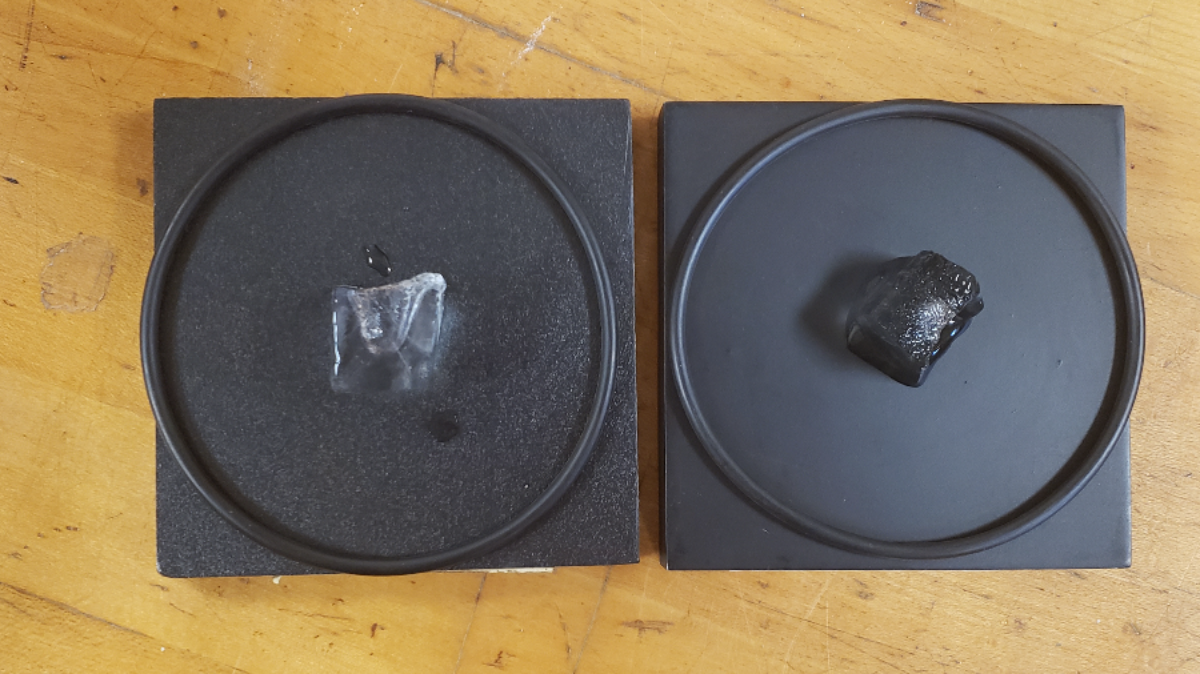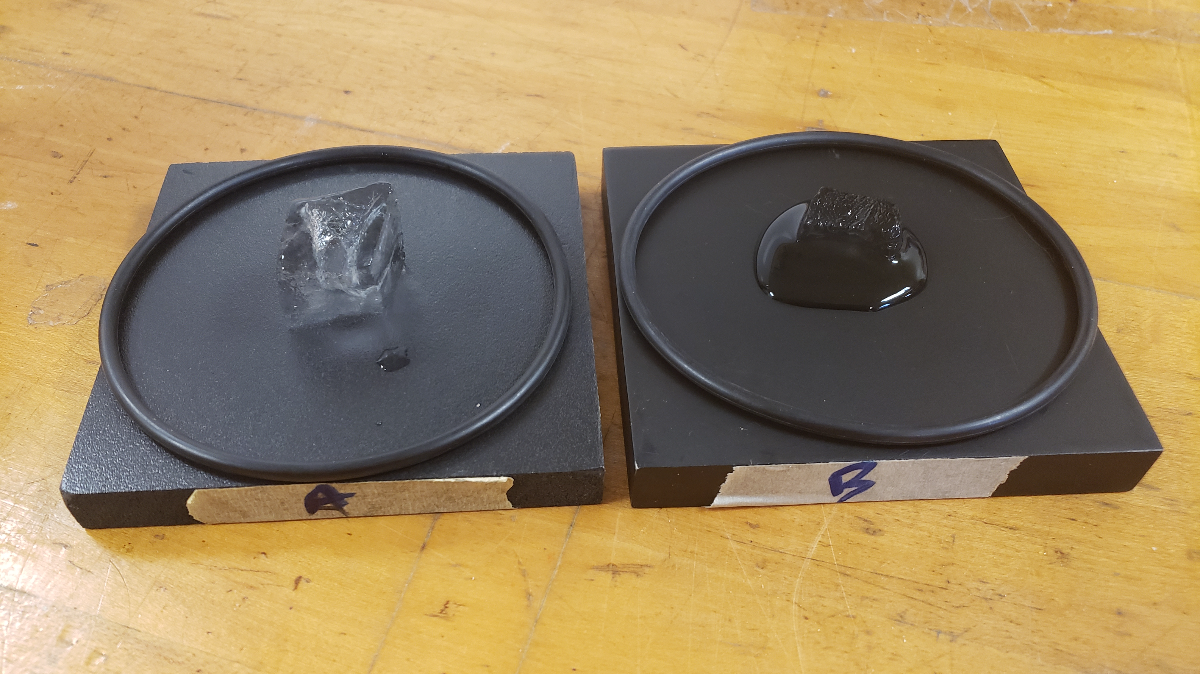Overview
This investigation challenges student thinking about heat and conduction through comparison of how ice melts on different materials. Students make predictions, observations and explanations, using these to consider why something feels hot or cold. So-called Melting Blocks are typically used for this investigation, but everyday classroom materials can be used successfully instead.
- Grades 4-12
- In person and virtual visit options available.
- For in person visits, access to ice is required.
- For virtual visits, the teacher and/or students will have to supply the materials.
This investigation challenges student thinking about heat and conduction through comparison of how ice melts on different materials. Students make predictions, observations and explanations, using these to consider why something feels hot or cold. So-called Melting Blocks are typically used for this investigation, but everyday classroom materials can be used successfully instead.
- Grades 4-12
- In person and virtual visit options available.
- For in person visits, access to ice is required.
- For virtual visits, the teacher and/or students will have to supply the materials.
Materials
-
Ice
-
Melting blocks
OR
- One item from list A and one item from list B below. A great combination is to have one metal ruler and one wood or plastic ruler or to use two blocks from a density block kit.
-
List A: items made from wood, rubber or plastic
-
List B: metal ruler or spoon, baking tin, non-stick pans
-
Ice
-
Melting blocks
OR
- One item from list A and one item from list B below. A great combination is to have one metal ruler and one wood or plastic ruler or to use two blocks from a density block kit.
-
List A: items made from wood, rubber or plastic
-
List B: metal ruler or spoon, baking tin, non-stick pans
-
Follow Up and Resources
This can be an effective launch point to dig deeper into heat transfer and thermal conductivity. Check out the following:
-
Our Stormy Weather investigation that considers heat transfer and convection in the context of hurricanes.
-
Can Humans Really Feel Temperature? video on thermal conductivity from minutephysics.
-
Misconceptions about Heat video from Veritasium.
This can be an effective launch point to dig deeper into heat transfer and thermal conductivity. Check out the following:
-
Our Stormy Weather investigation that considers heat transfer and convection in the context of hurricanes.
-
Can Humans Really Feel Temperature? video on thermal conductivity from minutephysics.
-
Misconceptions about Heat video from Veritasium.
Standards
Energy Transfer and Transformations
- SC.4.P.11.1: Recognize that heat flows from a hot object to a cold object and that heat flow may cause materials to change temperature.
- SC.4.P.11.2: Identify common materials that conduct heat well or poorly.
- SC.7.P.11.1: Recognize that adding heat to or removing heat from a system may result in a temperature change and possibly a change of state.
- SC.7.P.11.4: Observe and describe that heat flows in predictable ways, moving from warmer objects to cooler ones until they reach the same temperature.
Energy
- SC.7.P.11.4: Differentiate among conductors, semiconductors, and insulators.
- SC.912.P.10.4: Describe heat as the energy transferred by convection, conduction, and radiation, and explain the connection of heat to change in temperature or states of matter.
- SC.912.P.10.5: Relate temperature to the average molecular kinetic energy.
Properties of Matter
- SC.8.P.8.4: Classify and compare substances on the basis of characteristic physical properties that can be demonstrated or measured; for example, density, thermal or electrical conductivity.
The Practice of Science
- SC.4.N.1.6: Keep records that describe observations made, carefully distinguishing actual observations from ideas and inferences about the observations.
- SC.6.N.1.1/ SC.7.N.1.1/ SC.8.N.1.1: Define a problem from the sixth/seventh/eighth grade curriculum, use appropriate reference materials to support scientific understanding, plan and carry out scientific investigation of various types, such as systematic observations or experiments, identify variables, collect and organize data, interpret data in charts, tables, and graphics, analyze information, make predictions, and defend conclusions.
-
-
Pose answers, explanations, or descriptions of events
Energy Transfer and Transformations
- SC.4.P.11.1: Recognize that heat flows from a hot object to a cold object and that heat flow may cause materials to change temperature.
- SC.4.P.11.2: Identify common materials that conduct heat well or poorly.
- SC.7.P.11.1: Recognize that adding heat to or removing heat from a system may result in a temperature change and possibly a change of state.
- SC.7.P.11.4: Observe and describe that heat flows in predictable ways, moving from warmer objects to cooler ones until they reach the same temperature.
Energy
- SC.7.P.11.4: Differentiate among conductors, semiconductors, and insulators.
- SC.912.P.10.4: Describe heat as the energy transferred by convection, conduction, and radiation, and explain the connection of heat to change in temperature or states of matter.
- SC.912.P.10.5: Relate temperature to the average molecular kinetic energy.
Properties of Matter
- SC.8.P.8.4: Classify and compare substances on the basis of characteristic physical properties that can be demonstrated or measured; for example, density, thermal or electrical conductivity.
The Practice of Science
- SC.4.N.1.6: Keep records that describe observations made, carefully distinguishing actual observations from ideas and inferences about the observations.
- SC.6.N.1.1/ SC.7.N.1.1/ SC.8.N.1.1: Define a problem from the sixth/seventh/eighth grade curriculum, use appropriate reference materials to support scientific understanding, plan and carry out scientific investigation of various types, such as systematic observations or experiments, identify variables, collect and organize data, interpret data in charts, tables, and graphics, analyze information, make predictions, and defend conclusions.
-
-
Pose answers, explanations, or descriptions of events
-





